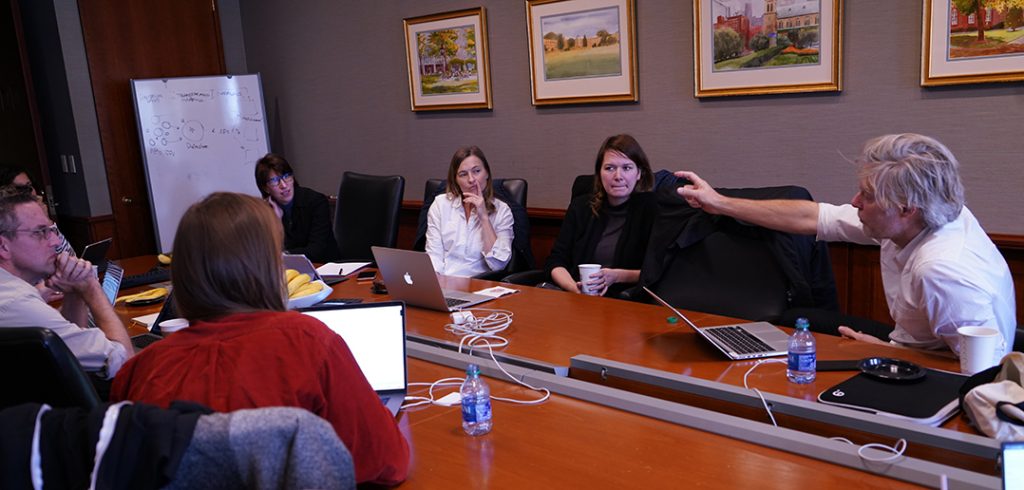“We hope to create a platform that will allow scholars and the general public to access data across museums through a simple and visually appealing online interface,” said Laura Auricchio, Ph.D., dean of Fordham College at Lincoln Center, a co-principal investigator for the project.
Several representatives from major museums and libraries, including the Metropolitan Museum of Art, the Museum of Modern Art, and the Library of Congress, were present at an October project workshop at Fordham. Joining them were scholars from Fordham, Harvard University, MIT, the New School, Sciences Po of Paris, and University of Potsdam in Germany. The group has been collaborating continually to produce a final report for the NEH in March, after which they’ll seek additional funding for the project.
Connecting Museums and Their Data
Auricchio said that the project is similar to how museums are connected in the physical realm through the exchange of traveling works of art, but instead of art they would be exchanging research data, or metadata, spawned by their collections. Auricchio distinguished the two data sets by using museum “tombstones” as an example. Tombstones are the placards one sees beside a painting in a museum. The metadata would be the boldfaced information found at the top of the placard: the name of the artists, the years the artist lived, the name of the work of art, and the medium. The research data would be the paragraph below the metadata, which would include more nuanced and detailed information about the painting: its history, influences, and place within art history. Also included in the research data would be essays from exhibition catalogs.
“Only a fraction of a museum’s holdings are photographed for catalogs, the rest is represented through this research data and metadata,” she said.
This new platform would help foster “a new kind of knowledge production for scholars, artists, curators, educators, and an interested public,” she said.
Anne Luther, Ph.D., a co-principal investigator on the project, said that one of the primary challenges is that museums publish their data in silos, and even within institutions the internal databases don’t necessarily follow the same protocol. Luther, along with Auricchio, brought the NEH-funded project to Fordham.
“A museum may have one database system they are using, but from department to department they are using it differently,” Luther said at the October workshop. “The goal is to make this data available as a public good, but at the moment they’re [the data] not speaking to each other.”
The challenge in dealing with large institutions is that the computer science protocols have already been established, in many cases over the course of years. Luther said there have been long-standing efforts that try to connect museum data internationally, but projects that have tried to impose new standards and new protocols have failed.
“We’re not trying to bring new standards to describing metadata, but rather we want to build, on one side, a protocol that would allow us to connect them,” she said. “We want to allow for the diversity of metadata on object descriptions within the museums to remain the same. We’re not asking the museum to rewrite. We’ll fish that out.”
Speaking the Same Language
Of course, “fishing” for common phases that describe a period, or a work of art, is also one of the great challenges for the project.
Sarah Schwettmann, a graduate student at Massachusetts Institute of Technology’s Center for Brains, Minds, and Machines, said a protocol layer that aligns metadata from museums’ digital collections could be the best route. She noted that with machine learning, which is akin to artificial intelligence, there are increasingly more tools that allow computer scientists to work with and analyze metadata. She said the resulting platform needn’t be a simple search engine or website, but could be something more.
“We could build a protocol that actually asks, ‘Can we compare how different museums talk about items in their collection?’” Schwettmann said at the workshop. “This interface would allow one to interoperate specific terms and cultural language that the various museums have developed over time. This is important because each museum develops bodies of scholarship that are specific to that institution.”
“We want a protocol layer that points back to how individual museums talk about their objects and allows users to interact with and see the diversity in terminology,” she said.
One-Stop Research
Matthew Battles, associate director, metaLAB at Harvard University, noted that today art historians will often need to travel from several galleries, museums, and archives in order to gather the strands of a story about a particular artist, particular genre, and particular period.
“We want to facilitate the research activity of a scholar who wants to tell those stories across an institutional context so that rather than spending five years visiting 25 institutions, they could have access to the data of those various institutions in one place,” he said.
He noted that while diverse institutions feature objects from similar periods in history, they may interpret that history differently. As an example, he noted that all institutions agree there was a Byzantine era, though not all agree on a start date or end date. Where one researcher might want to have a numerically specific date, another might be interested in how various institutions have defined Byzantine.
He said that rather than proposing yet one more system to bring all of the museum systems into alignment, which hasn’t worked anyway, it would be better to provide a “roadmap” of how you can bring the various data into agreement or, if one chooses, eliminate the distinctions.
Battles said the NEH seed money—known as a discovery grant—was key, since the resulting research would be a public good that could impact the way stories are told at exhibitions, in elementary school classrooms, and in higher education, all of which would be “more richly informed by a broader array of resources.”


